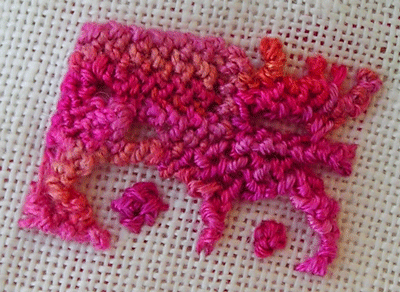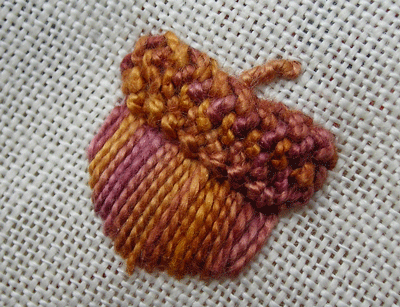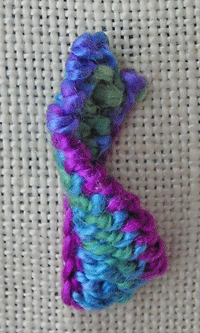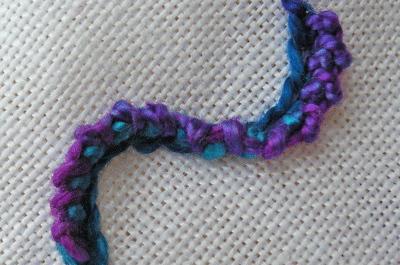On March 15, Sharon b announced the third Stitch Explorer challenge. She has posted wonderful examples of her own innovative work with the concept of Assisi embroidery along with the details and references to the traditional work.
As I read through Sharon’s post a small idea came to mind and I decided to make a soft transition from the trellis stitches of the second Stitch Explorer to the Assisi embroidery of the third challenge.

The workmanship is lacking as I was using some thread I’m not skilled with but the concept is very workable and it was a fun exercise. Below is a photo attempting to give a sense of the difference in height between the ground and the trellis stitches.

If you haven’t considered getting involved with Sharon’s Stitch Explorer challenge, please do look into it. Sharon has posted details about it here. If you’d like to see what others are doing, continue to check for comments in Sharon’s posts and there is a flickr group.
Before leaving the trellis stitch completely behind. I wanted to show one more of the samples I’d not yet posted. Doing some off grid work led to some trials without anchoring the stitches to a stitched line. Using an anchored thread to attach the beginning row of stitches gave me more freedom and ability to manipulate the line freely after stitching. It could be joined with other lines at will or remain isolated.

When I was finished with the little doodle, it looked to me as if somone with a wrinkled brow was peeking out of a window.
Update:
Many thanks for kind comments about this post. I have also received inquiries about how the trellis stitch work was managed as I worked around the motif pictured this post. It is hard for me to put into words. I’m sorry that there are no pictures just words as I’d not thought about photographing as I went along.
This is my best attempt to explain what I did. There may be much better ways to handle it. I’m no expert in stump work. Perhaps others may be able to help and know how to do it more easily. If so, please feel free to add a comment. I would appreciate learning more.
I started stitching the trellis stitch along one of the outer, non-diagonal sides. I stitched until I came to a place where the stitching would overrun the outline of the motif. In that row I anchored it where ever it met the motif’s outline. When that row was completed, I worked only back on it until the stitching meet the motif’s outline and went back and forth between the outside edge of the motif and the outer design outline. When that stitching came even with the last of the motif’s outline and the stitching could once again go across the design to the inside of other outer edge without covering the motif, I paused the stitching.
Next, I took up the outline of the other side in the same manner picking up on the last row of completed stitching on that side and so forth. When stitching on that side cleared the last of the motif’s outline I paused that stitching, too. I then took up the lower center “V” shape and worked from the point to the place it also cleared the motif’s outline and paused the stitching. I worked then worked next row completely across the design and catching in the stitching that had been paused and anchoring it to the motif’s outline where needed.
The only thing remaining for me was to pick up the stitching paused over the upper “V” shape and fill in that shape working towards the point. I’m sorry to use so many words, it is much easier done than read.







 Posted by Elizabeth
Posted by Elizabeth 































 Different view, same sample. Tacked to twist.
Different view, same sample. Tacked to twist.




